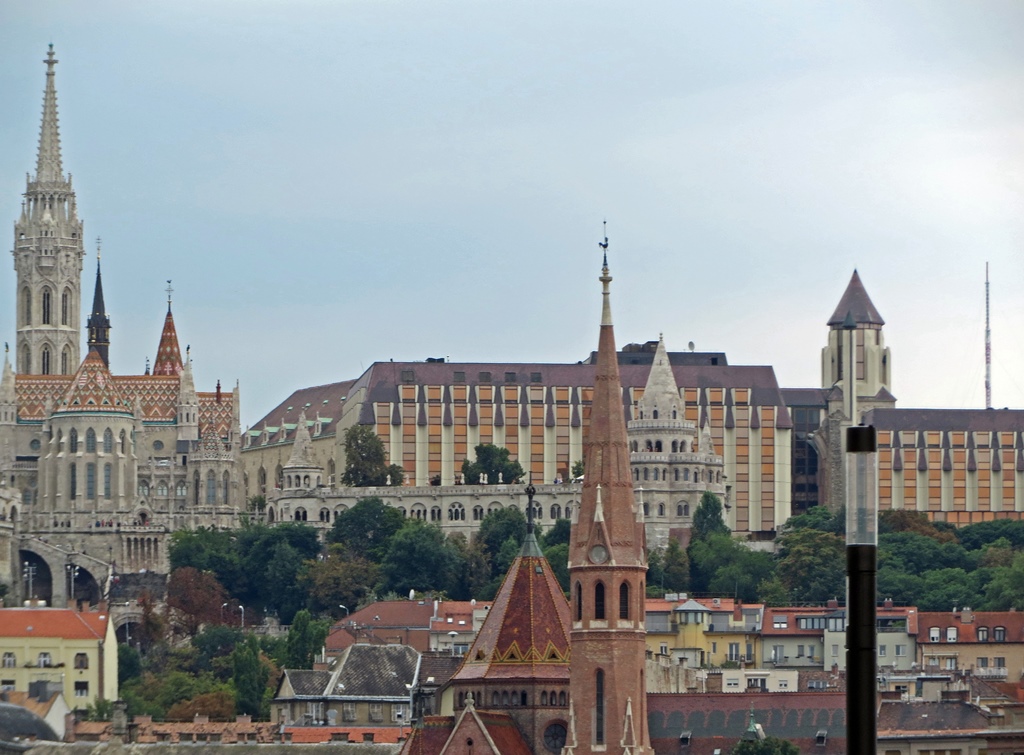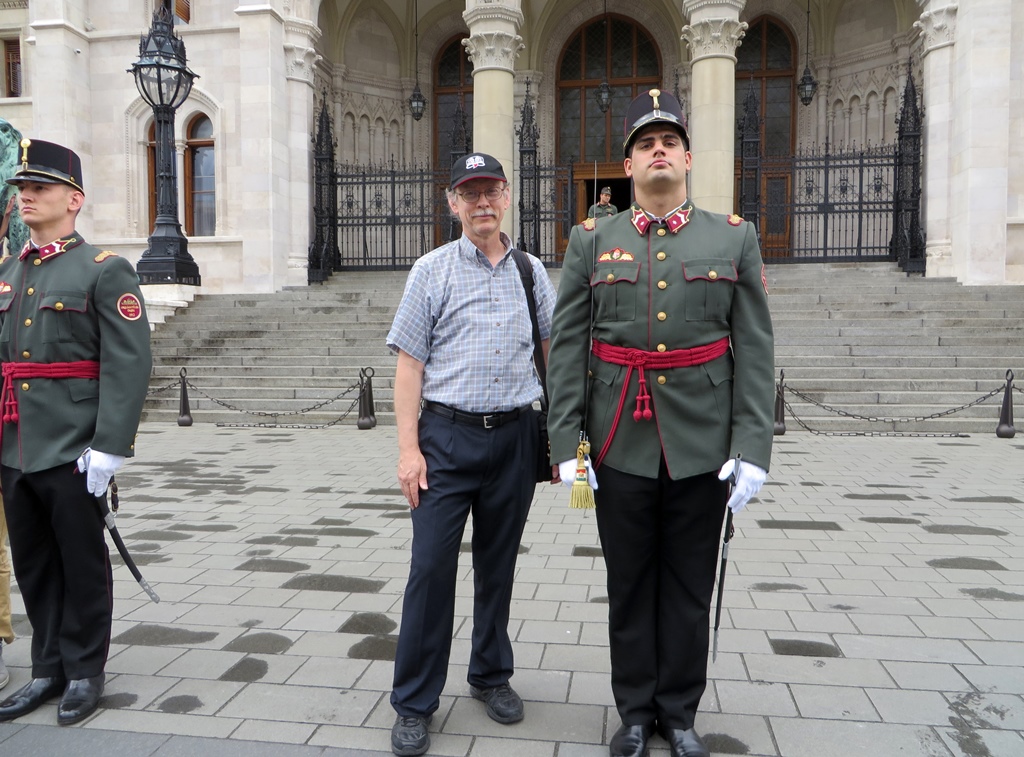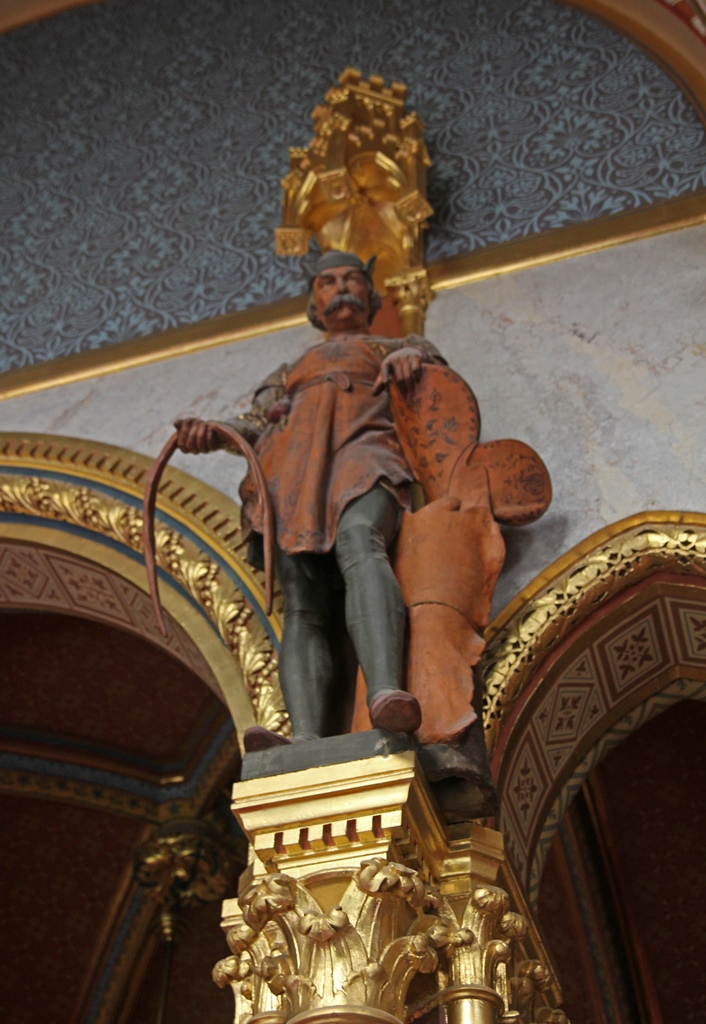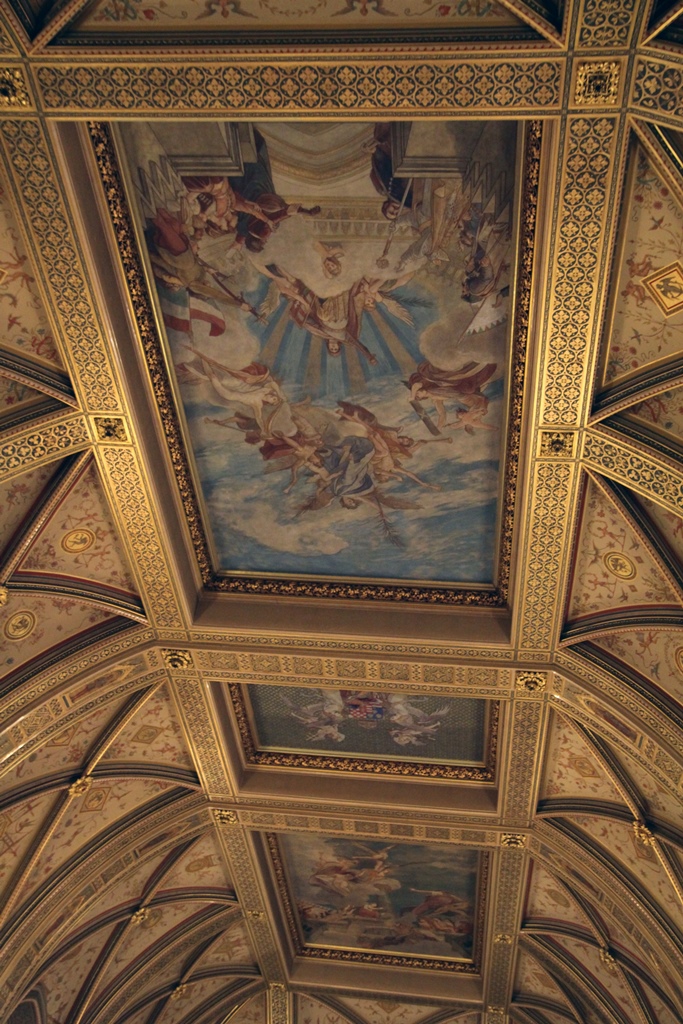We exited our Metro train at the Kossuth Lajos Tér stop and climbed up to street
level, putting us in a particularly scenic spot. To our left was the Danube River,
with some interesting structures on the other side.
Buildings Across Danube
But directly in front of us was our immediate destination, the Hungarian Parliament Building
(affectionately known as Országház to the locals). It was difficult to miss, being
879 feet long and 404 feet wide. Its central dome is 315 feet tall, a height it shares with
St. István's Basilica, making them both the tallest building in Budapest. There is a
significance to this height, but only if translated to meters, of which there are 96. The
building was inaugurated in 1896, which was considered to be the nation's millennium. I'm
not sure exactly what "inaugurated" means in this case, as the building wasn't actually
completed until 1904, but I'm sure there were ceremonies and celebrations, and a good time
was had by all.
The building was built in Gothic Revival style, with the dome being Renaissance Revival.
The building is covered with spires and columns and statues and delicate ironwork, none of
which stand up well to many years of the natural elements (and pollution). To keep the
building looking good, it’s in what's been described as "a perpetual state of restoration"
(part of this is an ongoing project to replace the soft limestone covering the building
with harder limestone). During the bad old days of the Warsaw Pact, there was a large red
star atop the dome, but this disappeared in 1990.

Parliament Building

Bob and Parliament Building
We made our way into the large square behind the building (thinking, maybe inaccurately,
of the river façade as the front), a square called Kossuth Lajos Tér (named after Lajos
Kossuth, a 19th Century Hungarian statesman who was an untiring but ultimately frustrated
advocate of Hungarian independence). When the Parliament Building was conceived by the
Hungarian Diet, an international competition was held in which architects submitted plans
for the building. The winner was a man named Imre Steindl, but plans from two other
competitors were also realized as the Ethnographic Museum and the Ministry of Agriculture,
located across Kossuth Lajos Tér from Parliament. The main entrance to Parliament is also
located on this square (though the tourist entrance is around at the north end of the
building).
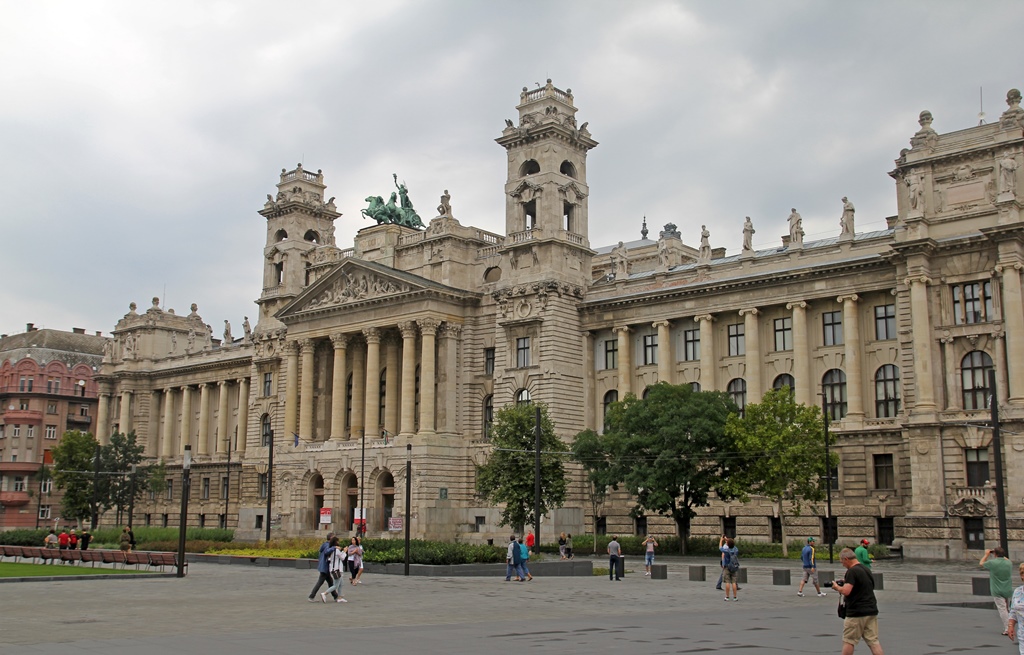
Museum of Ethnography
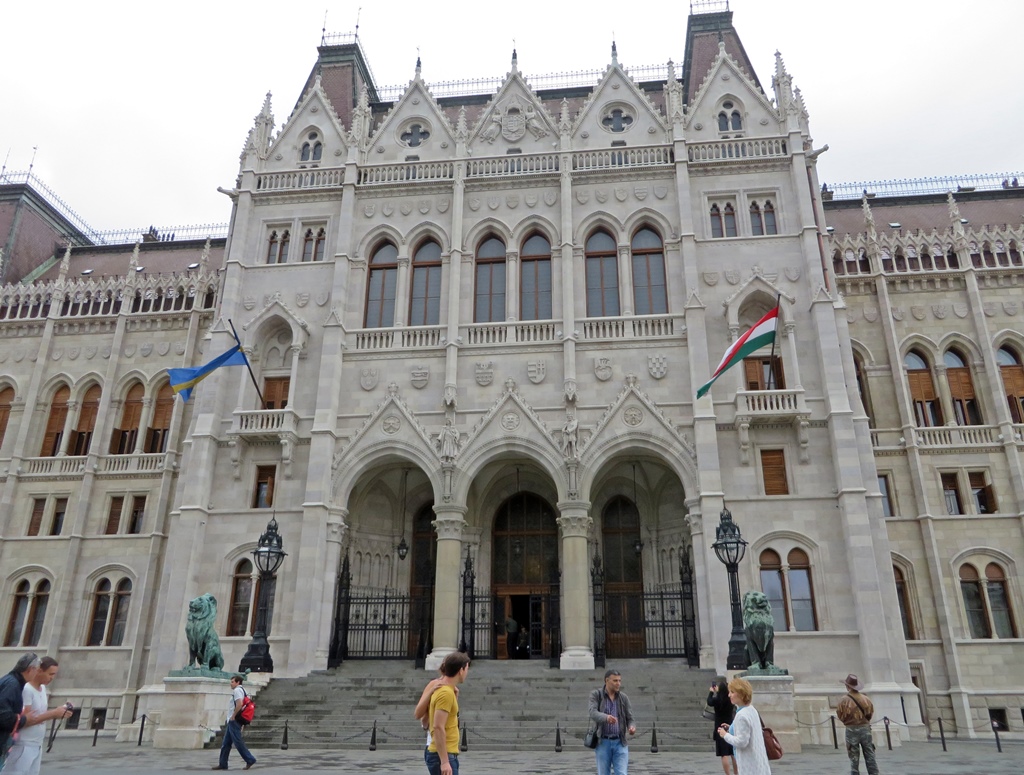
Main Entrance to Parliament
In the square there is a flagpole, and during our visit there were two armed guards next
to it, pacing slowly back and forth. One would have to suspect there were additional
guards somewhere, as it would have been difficult for these two to fight off a determined
assault (unless they were really, really good).
Kossuth Lajos Tér Guards
Our suspicion proved correct when a fanfare sounded from the Parliament entrance and
five more guards appeared on the entrance steps. They gradually made their way down
the steps, executing some complicated precision maneuvers along the way (to musical
accompaniment).

Guards Maneuvering

Guards Welcoming Tourists
The new guards didn't seem as though they would add much to the defense of the
Parliament Building, as they were apparently only armed with swords and seemed to
move pretty slowly. Again, there were no doubt others, less conspicuous and not
dressed as nicely, and presumably less friendly.
Bob Helping Guard
We continued northward through the square and around the north end of the building,
where we checked into how tours of the building worked. It turned out that there were
guided tours departing at specific times, and we had some time before the next
English-language tour. We used some of this time to walk around to the river side of
the building, to take some pictures.
Danube Façade of Parliament Building
We returned to the tour entrance, paid the fee and joined a tour group. At the time of
the building's construction, the legislature was composed of two bodies – an upper house
and a lower house. The building was constructed with two large wings to the north and
south of the central dome, for use by each of the two legislative houses (similar to the
arrangement of the U.S. Capitol Building). Since 1944 the legislature has consisted of
only one house, which operates in the south wing. The north wing is mostly used for tour
groups (like ours).
Our tour started along a plain hallway, but before long we were being marched up an
elaborately decorated stairway and along a corridor with statues along one side and
windows overlooking Kossuth Lajos Tér along the other. The Parliament Building was
constructed during a period of a booming Hungarian economy, and it was clear a lot of
forints (or whatever they were using back then) were spent on it.

Windows and Gold Vaulting, Staircase XVII

Corridor on Main Floor

Side Corridor
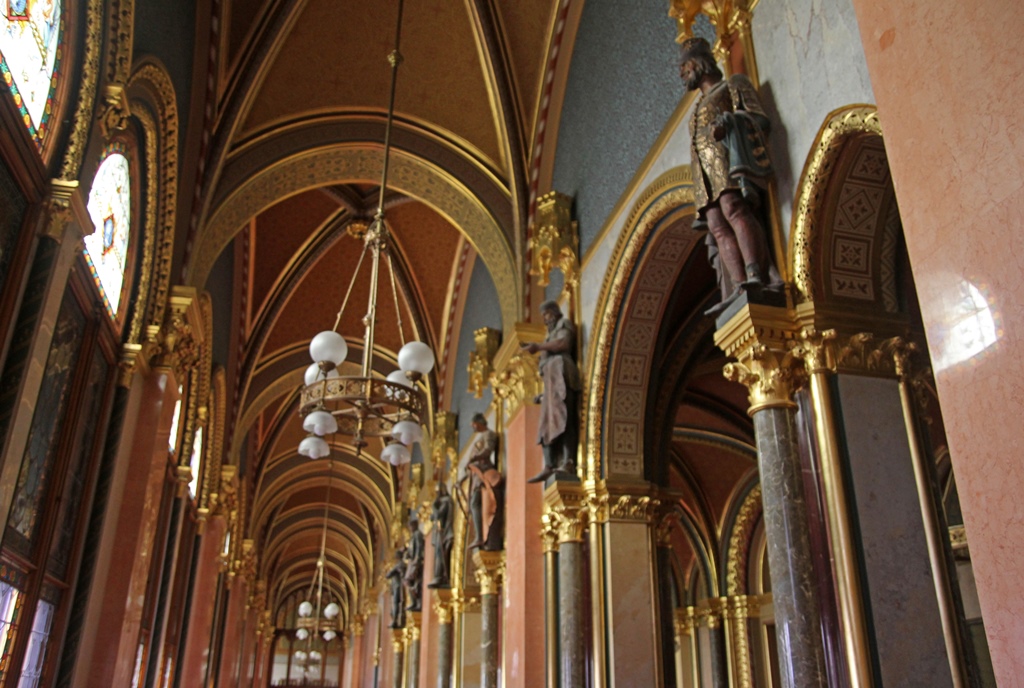
Statues, Main Floor Corridor
Statue, Main Floor Corridor
We soon reached the door to the Old Upper House Hall, a large room in which the
legislature's upper house once convened. Outside the door was an odd-looking rack
apparently made of brass, covered with curved indentations with numbers on them. The
guide told us that this was a cigar holder. When the upper house was in session,
smoking was forbidden inside the Hall, but was allowed in the hallway outside the
room. If a legislator was enjoying a cigar in the hallway when he was suddenly needed
inside (for a vote or as part of a discussion), he could temporarily place his stogie
in one of the indentations, noting the number, and return later to pick it up,
preventing both waste and cooties.
Numbered Cigar Holders
The Old Upper House Hall itself, now used for conferences and meetings, is also
lavishly decorated, with murals, oak and gold leaf. There is seating for 453
legislators.
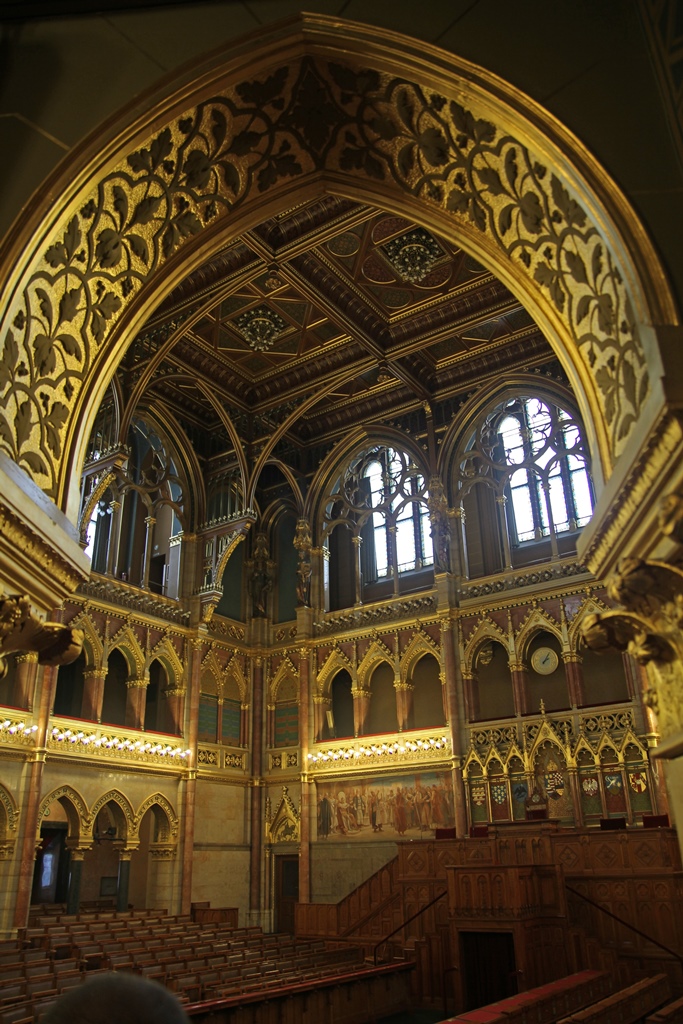
Old Upper House Hall

Seating and Tour Guide, Old Upper House Hall
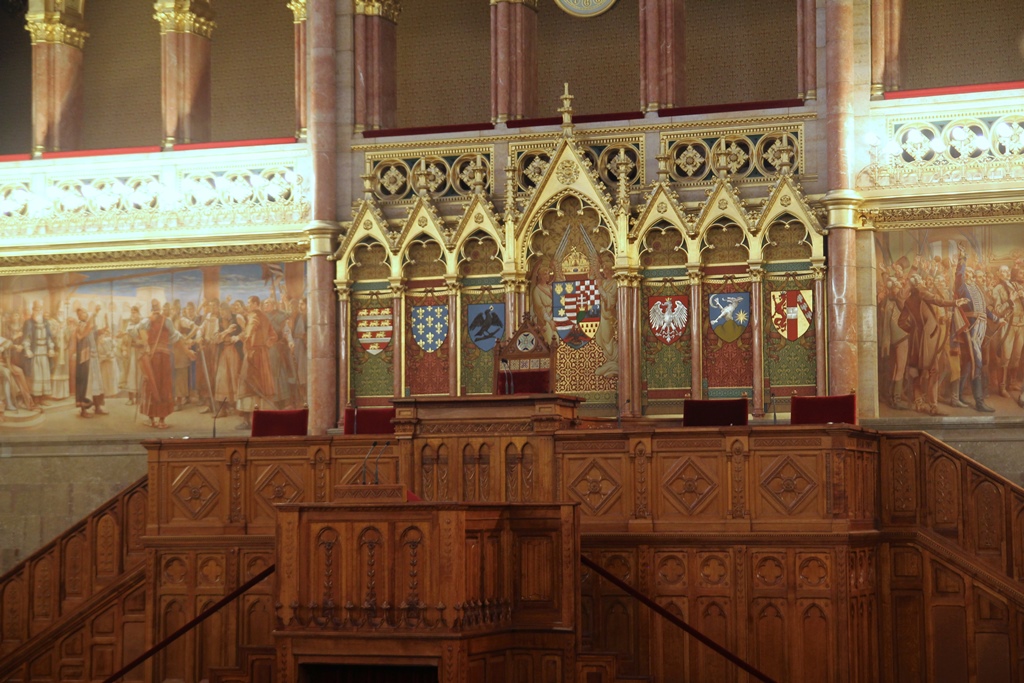
Podium, Old Upper House Hall
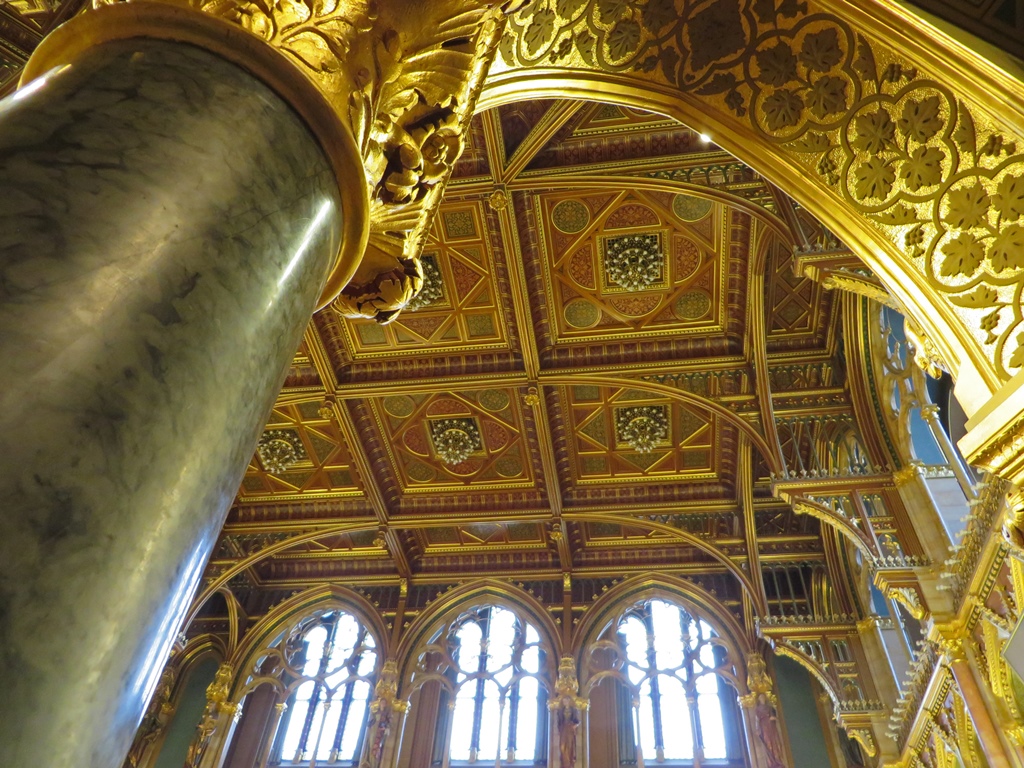
Windows and Ceiling, Old Upper House Hall
After emerging from the hall, we found ourselves in the Upper House Lobby, which was
also beautifully appointed. Among other features, there were several columns on which
statues were mounted. The carpet is the largest hand-knotted carpet in Europe.

Upper House Lobby
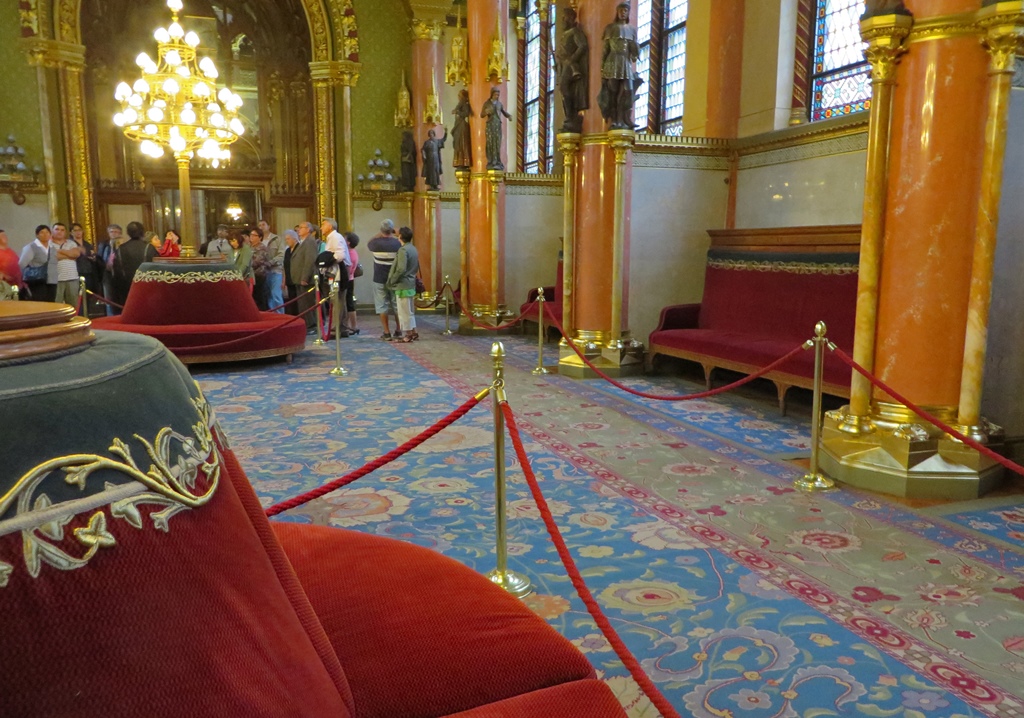
Carpet, Upper House Lobby

Statues, Upper House Lobby
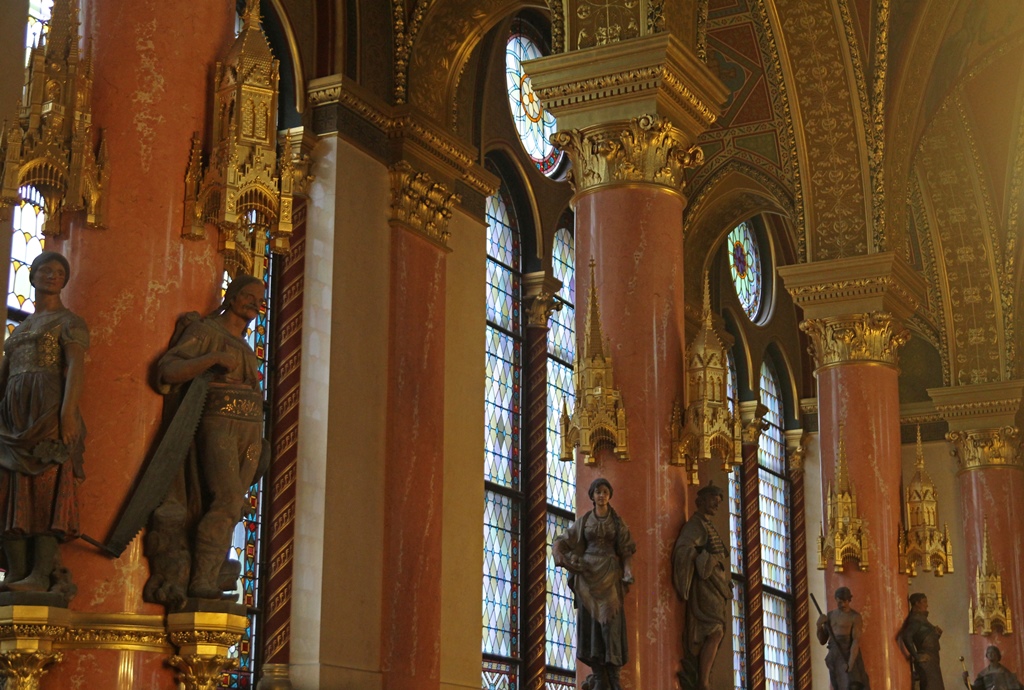
Statues, Upper House Lobby
From the lobby we proceeded into the Dome Hall, the large room under the building's central
dome and the symbolic center of the Hungarian government. This room is home to some very
special decorations and artifacts, the most important of which is Hungary's Holy Crown.
This crown is used for coronations only, and was used to crown more than 50 Hungarian
kings. It was last used to crown Charles IV, who became Hungary's (and Austria's) last
king in 1916 (the monarchy was abolished in 1918). It's not clear exactly how old the
crown is – it's sometimes called the Crown of Saint Stephen, but it probably isn't the one
used to crown Stephen I in 1000 A.D. (though some of the materials might go back that far).
Current estimates place the origin of the crown in its present configuration in the late
12th Century. The crown is covered with enamels and precious stones, and one particularly
distinctive feature: on top of the crown is a cross, and the cross is crooked. This seems
to have been the result of some undocumented accident in the 17th Century. While it looks
like something that could be easily fixed by good whack with a wooden mallet, it has been
deliberately left as-is. Paintings and engravings of the crown since that time have all
shown the crooked cross, and the present-day coat of arms for Hungary sometimes includes
this feature as well. The crown has a long history of being lost, found, hidden, sought
after and protected. After World War II it was recovered by the U.S. Army and kept in the
United States (in Fort Knox!) to protect it from the Soviets and from Hungary's Communist
government. It was returned to Hungary in 1978 via a complicated agreement that made sure
it was retained in the interest of the Hungarian people. It has been in its present position
since 2000.

Hungarian Holy Crown

Hungarian Coat of Arms
The crown display also includes the other elements of the coronation "insignia"
(sceptre, orb and mantle), all positioned directly beneath the center of the dome
and all under guard 24/7 (these were some of the non-friendly-looking guards).
Besides protecting the crown and the other items on display in the Dome Hall, the
guards also make sure that visitors are not taking photographs while in this room
(the picture above is a public domain Wikimedia photo).
From the Dome Hall we were walked into the building's official Entrance Hall, which
was obviously designed to impress. Surrounding us were a red-carpeted Grand
Staircase, many columns and statues, ceiling frescoes and lots of gold leaf.
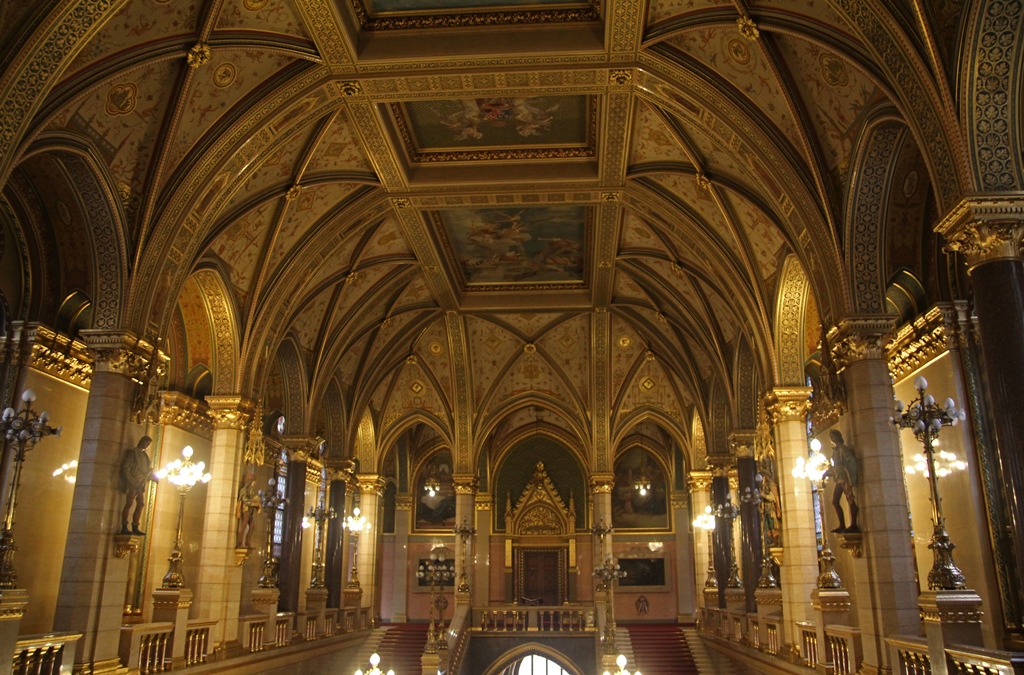
Upper Level, Entrance Hall
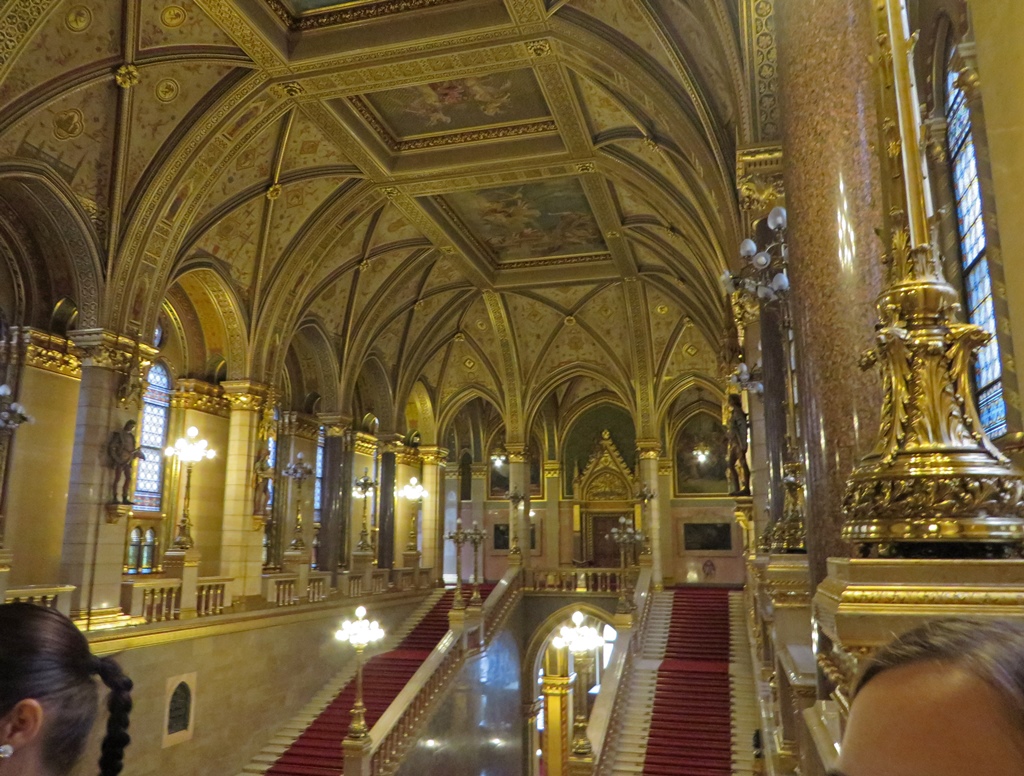
Grand Stairway, Entrance Hall
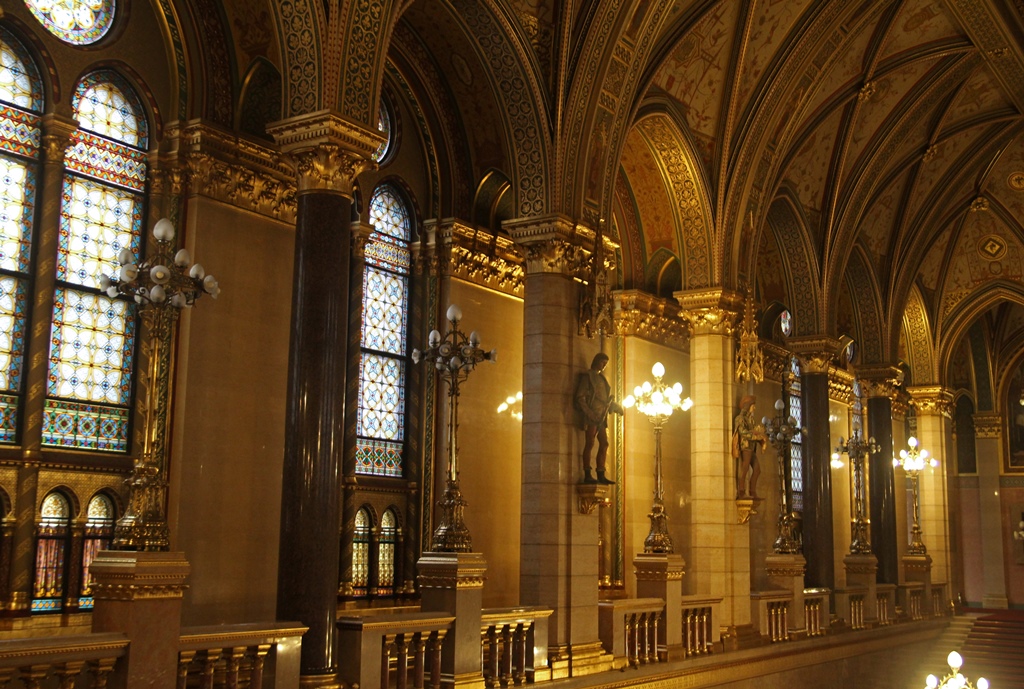
Upper Level, Entrance Hall
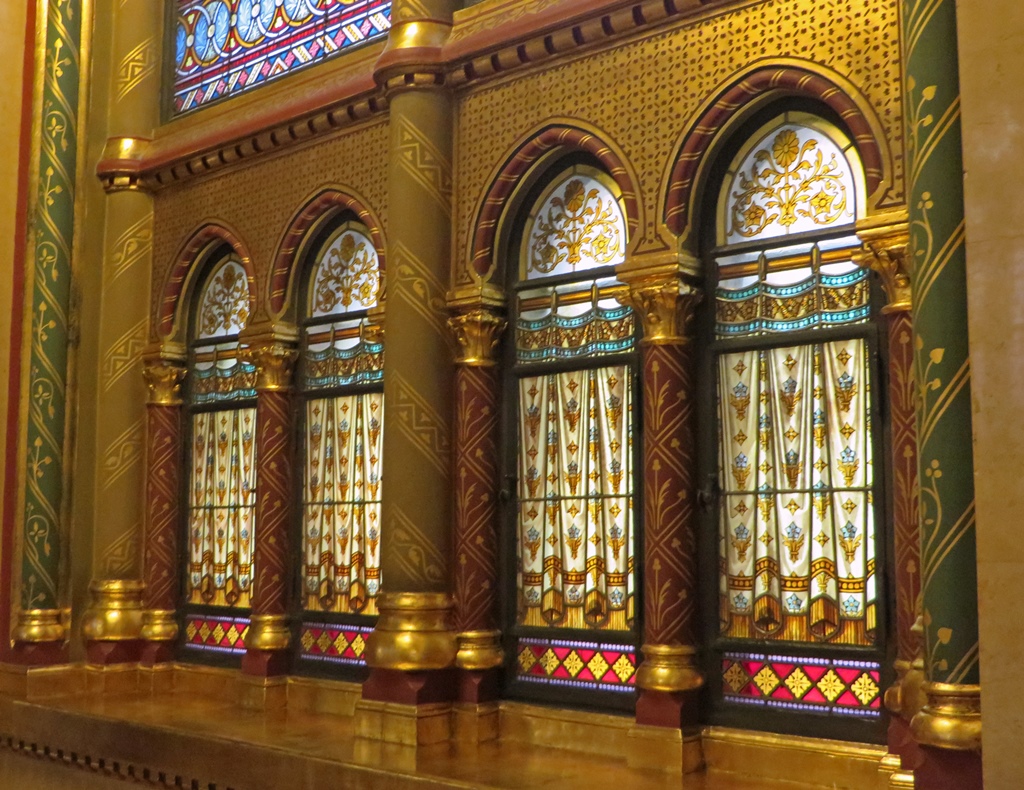
Windows, Entrance Hall
Ceiling Frescoes, Entrance Hall
Eventually we retraced our steps, back through the same corridor we'd used to enter,
pausing briefly for a quick look out the window at Kossuth Lajos Tér.

Walking Through Corridor

Museum of Ethnography, Kossuth Lajos Square
Emerging from the Parliament Building, we found a quick lunch and resolved to
complete some unfinished business. We wanted to visit the Matthias Church, which
had turned us away the day before. We crossed the river over to the Buda side and
closed in on our target.

